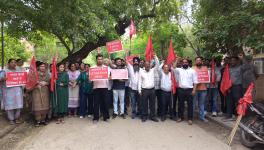Bengal: Jute Industry Crisis and Relevance of July 9 Countrywide Strike Call by TUs
The jute industry is one of the most manpower-intensive industries in West Bengal. There are about 60-73 operational jute mills in the state, according to IJMA (Indian Jute Manufacturers Association) and the National Jute Board. About 20 years ago, there were 59 jute mills in the state. Around 40 lakh farming families across India are engaged in growing jute, with a large share located in West Bengal.
While the exact state-level numbers of cultivators aren’t always separately reported, West Bengal leads in national jute acreage, with support from 40 lakh families across the countries.
The jute industry at present employs about 2.5-3 lakh direct workers in the state’s mills. IJMA cites that about 2.5 lakh are directly employed. The other sources combine permanent and contractual employees. Twenty years ago, there were about 4 lakh jute workers in the state, which shows that the number has dwindled.
Jute Production Volumes & Value
As per the National Jute Board, the total cultivated land under jute now is 799,000 hectares (average in the past four years), while raw jute + mesta production is 10.99 million bales (1 bale = 180 kg), out of which processed goods are made from composite jute mills producing about 1.066 million tonnes/year. The total exports are 138,000 tonnes/year, worth ₹2,168 crore, while domestic consumption is 994,000 tonnes/year.
The number of mills hasn't declined significantly over the past 20 years. Employment, however, has dropped from 4 lakh to 2.5–3 lakh persons, reflecting mechanisation, closures, and fewer permanent jobs.
Production remains robust at about 11 million bales raw production, 1 million tonne processed jute goods per year.
The jute industry—one of India’s oldest and most labour-intensive sectors—is currently passing through a severe crisis. Millions of workers who have contributed tirelessly to the nation’s economy are facing extreme deprivation. Their lives and livelihoods are endangered by the whims of mill owners’ negligence and the anti-worker policies of the ruling class.
In this context, the nationwide general strike call on July 9, 2025, is not just a protest, it is a historic moment of resistance, a juncture from which the working-class struggle can gain renewed momentum.
Multi-Dimensional Exploitation
Jute mill owners have, for years, denied workers even their most basic rights under various pretexts. Many mills continue to operate with century-old machinery from the British era, forcing workers to endure back-breaking physical labour, without receiving fair wages, social security, or even basic humane working conditions.
The work environment within mills is highly unhygienic and accident-prone. Most mills lack proper lighting, ventilation, safety mechanisms, or emergency rescue facilities. Workers are rarely provided with even the most basic safety gear—helmets, gloves, masks, boots, etc. They spend hours working in deafening noise, dust, darkness, and heat, and falling ill has become an everyday reality.
Adding to this is the collapsing state of ESIC (employees’ state insurance). Because employers often fail to deposit workers’ ESIC contributions on time, many are deprived of medical services. Even in case of accidents, the non-activation of ESI cards means workers face immense trouble accessing government hospital care. In many instances, a worker’s name isn’t even listed in the ESI database or appears as "inactive."
The situation with provident fund (PF) is equally alarming. While PF is deducted from workers’ wages every month, employers frequently fail to deposit the amount with the regional PF office. In mills with private PF trusts, the trusts are not managed according to the "Provident Fund Trust Rule," leading to discrepancies in year-end balances and uncertainty over retirement savings. Many times, PF account numbers are missing or incorrect, causing harassment and delay.
Even after retirement, workers face inordinate delays in receiving their rightful PF dues, with employers creating deliberate administrative hurdles. Most disgracefully, under the Employee Pension Scheme (EPS), many mill owners have failed to contribute to workers’ pension funds for years. As a result, retired workers often run from office to office, gathering documents—only to face denial of their pension.
The situation with gratuity is no better. Though legally entitled after five years of continuous service, many workers are deprived of gratuity through arbitrary transfers or loopholes. Even after retirement, years may pass before gratuity is disbursed—if at all. Those who attempt to file complaints are threatened or subjected to harassment.
Despite consistent agitation by trade unions, the apathy of mill owners and administrative authorities has left workers bereft of their hard-earned rights. Unless the signed tripartite agreements are implemented in full, this legitimate struggle will only intensify— an explosion of workers’ discontent seems inevitable.
From ‘Cut Duty’ to ‘Straight Duty’: A Cruel Transition
Earlier, the "cut duty" system allowed jute workers to work in shifts of 4, 6, or 8 hours. This flexibility accommodated family responsibilities, health concerns, and other practical needs, benefitting both workers and mill management.
But now, owners are unilaterally imposing a "straight duty" regime—forcing workers into full-day shifts from morning to evening. This not only increases physical and mental stress but also leads to job losses, especially for those who depended on part-time work to sustain their families. Women workers, in particular, are at high risk of losing employment under this new system.
Tripartite Agreement & June 4 Meeting: Hope or Deception?
The Tripartite Wage Agreement of January 3, 2024 promised that workers with 15 years of service in a mill would be designated as "special badli" and those with 20 years’ would be made permanent. This was the result of years of struggles, but in practice, owners have only evaded implementation.
Finally, at a meeting chaired by the State Labour Minister on June 4, 2025, a decision was taken that workers who had 70% attendance between January 1, 2021 and May 31, 2025, would be eligible for these changes. But is this a real opportunity or just another trap?
Given the strenuous nature of the work, poor health, accident risks, and the outdated "cut duty" system, many long-serving workers may not meet the 70% attendance threshold. Thus, even after working 15–20 years in a single mill, they risk losing out on rightful recognition due to technicalities.
So, while jute workers continue to labour in hazardous and exploitative conditions, their legal, economic, and social rights are under attack. If this is the situation under existing labour laws, one can only imagine the disaster that would unfold if the corporate-driven new labour codes are implemented.
The cruel neglect of workers’ lives and futures can no longer be tolerated. That is why the July 9 general strike has become a vital moment of resistance—a united step forward against the ongoing exploitation of workers.
Historical Continuity of Strikes & Worker Unity
In the history of India’s labour movement, strikes have never been mere protests—they have been instruments of dignity and rights. Since the onset of liberalisation in 1991, the Centre of Indian Trade Unions (CITU) has led the way in resisting these new attacks. Back then, only a few unions, like AITUC, HMS, UTUC, joined this bold stand.
Over time, with each general strike—particularly in 2012, 2016, and 2020—more unions and federations have joined the movement. Even previously passive organisations were compelled to participate for survival.
CITU’s position has been consistently clear—not only in defence of workers’ rights but also for their political empowerment. The unity forged through these joint struggles has laid the foundation for a broader political alternative in the future.
July 9 Strike: A Defining Moment for Jute Workers
In this context, the July 9 general strike is of particular significance for jute workers because:
--It creates a renewed opportunity to demand full implementation of the tripartite agreement.
--It brings together workers from other sectors in support of jute workers’ demands for PF, ESI, attendance bonus, permanency, and more.
--It provides momentum to oppose "straight duty" and reinstate the more humane "cut duty" system.
--It intensifies the demand for scrapping the anti-worker Labour Codes and restoring full implementation of existing labour laws.
And most importantly, it helps build unity against the corporate auctioning of public resources and the future of workers through divisive policies.
A New Chapter in the Struggle for Change
The plight of jute workers today is so severe that their struggle is not theirs alone—it is the struggle of every working person in India for dignity, security, and a future. This is not just a list of demands—it is a political stance, a cry for change in the anti-worker policies of the State. If the government refuses to listen, this movement will evolve into a force strong enough to change the government itself.
Thus, the success of the July 9 strike depends on the united participation of jute workers, workers from all organised and unorganised sectors, employees of public and private establishments, and all working people of our society.
It is this unity that will ultimately determine who stands on the right side of history—and who stands with corporate interests.
The writer is a leading trade union organiser in West Bengal and the Working President of CITU-affiliated Bengal Chatkal Mazdoor Union.
Get the latest reports & analysis with people's perspective on Protests, movements & deep analytical videos, discussions of the current affairs in your Telegram app. Subscribe to NewsClick's Telegram channel & get Real-Time updates on stories, as they get published on our website.
























